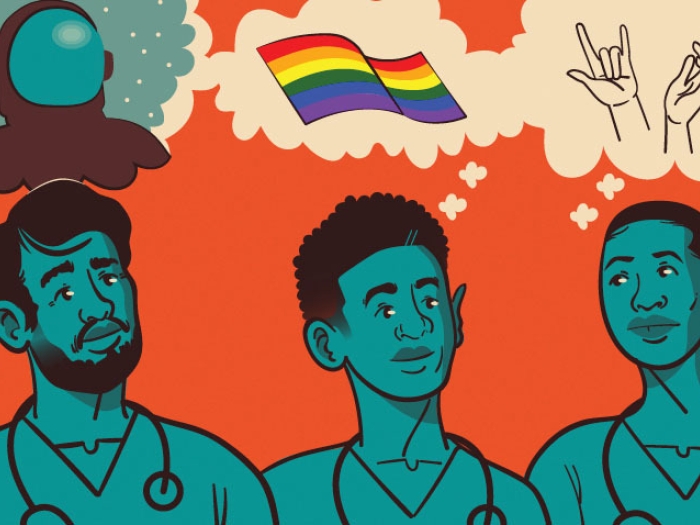A team of educators propose a plan that supports individuals in succeeding after medical school.
8:47 AM
Author |

As the health care environment continues to evolve, medical educators are dedicated to ensuring the next generation of physicians is prepared to provide high-quality patient care.
And because of this, the value in preparing future physicians is extremely high, as competency-based medical education (CBME) is quickly becoming the cornerstone of medical education programs throughout the United States.
"The fundamental principles of CBME include many patient-centric objectives, as well as the idea that the continuum of education, training and practice for aspiring physicians should be seamless," says Helen Kang Morgan, M.D., associate professor of obstetrics and gynecology and learning health sciences at the University of Michigan Medical School.
However, the continuum from undergraduate medical education to graduate medical education is far from seamless.
"We are at a point in time where we can recognize that there is a need for more meaningful communication for our students during this important educational milestone in their academic careers," says Morgan. "We know that more needs to happen in the year before they enter residency programs and transition into the next phase of their education."
This notion inspired Morgan and a collaborative team of physician educators to author a perspective on the importance of delivering a responsible medical school to residency educational handover.
Their work was recently published in the journal of Academic Medicine.
Course breakdown
At a recent American Medical Association Accelerating Change in Medical Education consortium, Morgan and her peers engaged in a series of conversations about how to best improve the undergraduate to graduate transition.
We are at a point in time where we can recognize that there is a need for more meaningful communication for our students during this important educational milestone in their academic careers.Helen Kang Morgan, M.D.
During this discussion, many participants proposed providing learner performance measures for students entering their next level of training after their final year of medical school.
"At this meeting, it became increasingly evident that medical educators were searching for a tool that would help students excel in their graduate medical studies and subsequently, in their future careers as physicians," says Morgan. "We also knew that developing concrete recommendations for the medical education community could help inform policies and best practices for this transition."
Therefore, Morgan and her fellow educators developed five recommendations for successful educational handovers:
-
The overarching purpose of the educational handover should always be to provide medical school performance data that guides continued improvement in student ability and performance.
-
The process used to create an educational handover should be philosophically and practically aligned with the student's continuous quality improvement in mind.
-
The educational handover should be student-driven with a focus on individualized learning plans that are coproduced by the student, as well as a coach or advisor.
-
The transfer of information within an educational handover should be done in a standardized format.
-
Together, medical schools and residency programs must invest in adequate infrastructures that support student improvement plans.
"Traditionally, efforts to improve communication at the medical school to residency transition point have mostly focused on the residency application process," says Morgan. "But with these clearly identified objectives, medical educators can better ensure their students thrive during this educational transition."
Future success
Overall, an educational handover at the end of medical school has the potential to both encourage and document student growth, including the achievement of core entry-level residency competencies.
"By keeping a spotlight on performance during the final year of medical school, the handover can encourage individuals to develop personalized learning plans that work best for themselves," says Morgan. "It also encourages self-directed learning practices throughout medical school, which involves students identifying their own gaps in knowledge, skills and attitudes, and then creating plans to fill these gaps."
Morgan adds that self-directed learning is often limited during medical training due to a general lack of feedback, which leads to challenges with gap identification and difficulty with formulating action plans.
"However, an educational handover from medical student to resident would serve as an opportunity to singlehandedly address these challenges and allow graduating medical students to be an engaged participant in their future success," says Morgan.
Currently, pilot educational handovers have been sent to residency program directors for University of Michigan Medical School students entering emergency medicine, surgery, pediatrics, and obstetrics and gynecology residencies.
Paper cited: Helen K. Morgan, et al. "A Responsible Educational Handover: Improving Communication to Improve Learning" Academic Medicine. DOI: 10.1097/ACM.0000000000002915
Other pilots have been initiated at Oregon Health & Science University, Virginia Commonwealth University School of Medicine, University of Virginia and Vanderbilt University School of Medicine.

Explore a variety of health care news & stories by visiting the Health Lab home page for more articles.

Department of Communication at Michigan Medicine
Want top health & research news weekly? Sign up for Health Lab’s newsletters today!





